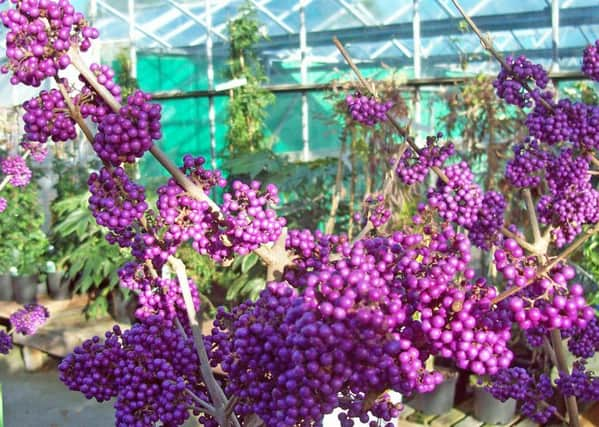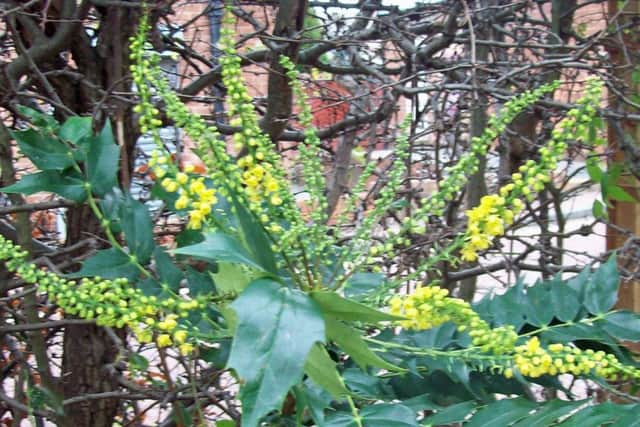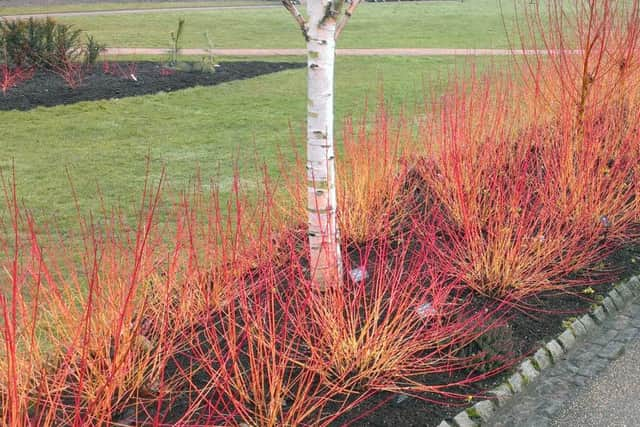GARDENING: Winter shrubs bring both colour and scent
This article contains affiliate links. We may earn a small commission on items purchased through this article, but that does not affect our editorial judgement.


Most of these plants are suitable for small gardens, with a selection of coloured bark, berries and scented flowers to lighten the darkest of days.
Oregon grape (Mahonia × media Charity, Winter Sun or Soft Caress): yellow spikes of flowers in November and December, evergreen holly-like leaves - dwarf Soft Caress (height 1m) has spine-free leaves. Lily-of-the-valley fragrance. Flowers November-March. Height 3-4.5m (10-15ft)


Advertisement
Hide AdAdvertisement
Hide AdDogwoods (Cornus): grown for their winter stem colour, Midwinter Fire (C. sanguinea) has orange, pink and red branches. Other colours are C. alba Sibirica, (red); C. sanguinea Winter Beauty (orange-red); C. stolonifera Flaviramea (acid green/yellow); C. alba Kesselringii (dark purple/almost black), with purple-green foliage; C. alba Aurea (red stems, golden foliage). Height approx 1.5m, prune hard in spring.
Mexican orange blossom (Choisya ternata): Sundance is a rounded dense shrub, evergreen with bright yellow-green glossy leaves. Scented white star shaped flowers in clusters in late spring. Aromatic leaves. Height up to 2.5m.
Beautyberry (Callicarpa bodinieri Profusion): a deciduous shrub with purplish leaves when young, turning rosy-pink in autumn. Berries 4mm, violet-purple, in compact clusters. There is also a white version. Height 3m.
Dawn viburnum (Viburnum x bodnantense): Dawn is a large deciduous shrub with clusters of scented, light pink and white flowers opening from autumn to spring, from red buds. Height up to 2.5m.


Advertisement
Hide AdAdvertisement
Hide AdWillow (Salix): Pollarded as shrubs for colourful stems. Ideal for wet areas. S. alba Britzensis produces bright orange rods; the violet willow, S. daphnoides, has stems coated with a grey-white bloom. In February, the wands produce silvery ‘pussy willow’ catkins. Other good willows are S. phylicifolia (brownish-purple stems); S. alba vitellina (golden yellow); S. alba Yelverton; S. alba var. vitellina yellow/orange stems); S. alba var. vitellina Britenzis (orange); S. gracilistyla Melanostachys (black catkins and brick-red anthers).
Sweet box (Sarcococca confusa): a vanilla-scented evergreen shrub with white flowers and lustrous, dark green leaves. Flowers December-March. Height 2m.
Winter daphne (Daphne odora): fragrant pink or white winter flowers. Variegated daphne (D. odora Aureo-Marginata) lights up the winter garden with its green and white foliage. Flowers December-March. Height 1.5m.
Russian sage (Perovskia atriplicifolia Blue Spire): produces a winter framework of silver-white stems. Height 1m.


Advertisement
Hide AdAdvertisement
Hide AdSkimmia Kew Green and Rubella (Skimmia x confusa): compact mounds of evergreen foliage supporting conical heads of ivory-white buds (Kew Green); Rubella has red buds all winter. Height 1.5m.
JOBS FOR THE WEEKEND
Alpines can be sown from seed, as they need a period of cold to break their dormancy. A moveable cold frame can be positioned over the sown area to protect it from excessive wet. Alternatively, the seeds can be put in the fridge, for sowing next spring. This will really upset your family.
Winter can be a tough time for birds in terms of water and food, so keep supplies well topped up. Once you start feeding, don’t stop – they will come to depend on it.


Pot up Hippeastrum (amaryllis) bulbs, and bring them back into active growth with regular watering and feeding. They should give you beautiful flowers in the new year.
Advertisement
Hide AdAdvertisement
Hide AdPlant tulip bulbs at the latest now. Some species tulips go on year to year, some are treated as bedding, and replaced every year.
Apply a mulch to protect plants that are borderline hardy such as Agapanthus, Kniphofia and Phygelius. The plants’ own leaves, e.g. Kniphofia, can be tied up and used as protection for the crowns underneath.
Helleborus niger (Christmas rose) blooms can look unsightly when splashed with muddy raindrops. A mulch will reduce this, and cloches can always be used where practical.
Continue to plant roses. Avoid planting in areas where roses were previously grown otherwise new introductions may suffer from replant diseases (rose sickness).
Advertisement
Hide AdAdvertisement
Hide AdShrubs normally pruned hard in the spring - such as Buddleja davidii, Cornus alba and Lavatera – can be cut back by half now, to prevent wind rock and neaten their appearance.
Ensure any pruning of Acer (maple) and Betula (birch) is completed before the end of the month to avoid bleeding of sap from cuts.
Make sure you have removed all shading from the greenhouse panes, in order to maximise light levels. If applying insulation, attach it only to the sides and north-facing roofs to let in as much light as possible.
Avoid buying poinsettias that have been accidentally chilled, particularly those sold from street stalls on cold days. Once home, place them in a warm, light place, away from drafts, to ensure they last for as long as possible.
Advertisement
Hide AdAdvertisement
Hide AdPlace hyacinths in a cool, bright place in the home. If it’s too warm, the leaves will elongate and the flowers will fade quickly.
GET IN TOUCH
For more on these topics, plus cook what you grow, traditional recipes, North East information, environmental news and more, log on to www.mandycanudigit.com (now smartphone friendly), www.sunderlandecho.com/gardening, follow me on Twitter @MandyCanUDigIt or you can like me on Facebook at Mandycanudigit